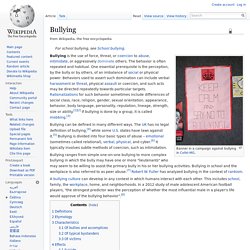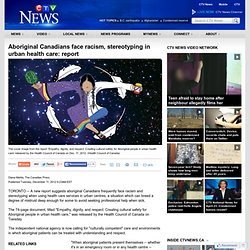

Bullying. Banner in a campaign against bullying in Cefet-MG.

Bullying can be defined in many different ways. The UK has no legal definition of bullying,[4] while some U.S. states have laws against it.[5] Bullying is divided into four basic types of abuse – emotional (sometimes called relational), verbal, physical, and cyber.[6] It typically involves subtle methods of coercion, such as intimidation. Apartheid. Apartheid, ( Afrikaans: “apartness”) policy that governed relations between South Africa’s white minority and nonwhite majority and sanctioned racial segregation and political and economic discrimination against nonwhites.

The implementation of apartheid, often called “separate development” since the 1960s, was made possible through the Population Registration Act of 1950, which classified all South Africans as either Bantu (all black Africans), Coloured (those of mixed race), or white. A fourth category—Asian (Indian and Pakistani)—was later added.
Racial segregation, sanctioned by law, was widely practiced in South Africa before 1948, but the National Party, which gained office that year, extended the policy and gave ... (100 of 758 words) <ul><li><a href="/EBchecked/media/95471/A-South-African-beach-during-the-apartheid-era? TopicId=29332"><img src=" alt="apartheid: South African beach during the apartheid era" /><span>A South African beach during the apartheid era. Regional discrimination in China. Regional Discrimination in China or Regionalism is overt prejudice against demographic groups based on their places of origin or their current provincial zones.

China's sheer geographic size and human mass renders much demographic understanding tied to locality, and there is often little life movement outside of a citizen's province of birth. Treatment of regional groups can hinge on preferential assumptions based on places of upbringing, and is often most pronounced towards those born external to urban zones. When a Chinese migrant settles in a new region, local residents can develop social attitudes and prejudgments based on the newcomer's place of birth. Amnesty International. Eugenics. While eugenic principles have been practiced as far back in world history as Ancient Greece, the modern history of eugenics began in the early 20th century when a popular eugenics movement emerged in Britain[8] and spread to many countries, including the United States and most European countries.

In this period, eugenic ideas were espoused across the political spectrum. Consequently, many countries adopted eugenic policies meant to improve the genetic stock of their countries. Jim Crow Laws. “Marriages are void when one party is a white person and the other is possessed of one-eighth or more negro, Japanese, or Chinese blood.”

—Nebraska, 1911 “Separate free schools shall be established for the education of children of African descent; and it shall be unlawful for any colored child to attend any white school, or any white child to attend a colored school.” —Missouri, 1929 “All railroads carrying passengers in the state (other than street railroads) shall provide equal but separate accommodations for the white and colored races, by providing two or more passenger cars for each passenger train, or by dividing the cars by a partition, so as to secure separate accommodations.” —Tennessee, 1891 See more Jim Crow laws Restricted real-estate covenant In communities across the country, property owners signed agreements called restrictive covenants.
Aboriginal Canadians face racism. TORONTO -- A new report suggests aboriginal Canadians frequently face racism and stereotyping when using health care services in urban centres, a situation which can breed a degree of mistrust deep enough for some to avoid seeking professional help when sick.

The 74-page document, titled "Empathy, dignity, and respect: Creating cultural safety for Aboriginal people in urban health care," was released by the Health Council of Canada on Tuesday. The independent national agency is now calling for "culturally competent" care and environments in which aboriginal patients can be treated with understanding and respect. "When aboriginal patients present themselves -- whether it's in an emergency room or in any health centre -- they're not necessarily seen for who they are and consequently they're not respected, they're not engaged as fellow human beings and as a result the care they get suffers," John G. Abbott, CEO of the Health Council of Canada told The Canadian Press.